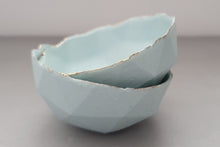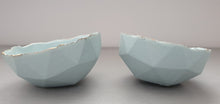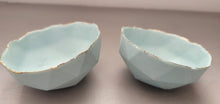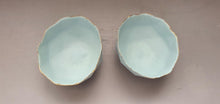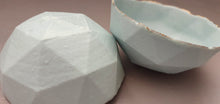
Geometric faceted polyhedron bowl in sky blue made from stoneware Parian porcelain with real gold finish - geometric decor
Handmade vessel from stoneware Parian porcelain in sky blue color.
In hemisphere shape.
Can be used as a decorative piece or a ring dish.
8cm in diameter and 5 cm high
*Because of the nature of my work and the material i use it is unlikely that further copies of this item will be produced in the future.*
Any imperfections which may occur are because they are handmade and when you work with such delicate and thin material factory perfection cannot be achieved.
Here is a bit about Parian porcelain .
It was named after Paros, a Greek island renowned for its fine-textured, white marble of the same name. It was first made in England in 1846 which succeeded in producing a very perfect imitation of marble, both in surface and in tint. The marble Parian Ware captivated Victorians. It allowed the middle classes to possess articles of high art. And by the end of the 19th Century, every properly furnished Victorian parlor contained at least one piece of it. Victorians welcomed Parian’s inexpensive, small-scale copies of busts of literary and political figures, as well as its decorative vases, boxes and pitchers, adorning their homes with these ornaments to show their gentility. It’s been said that Parian had the same effect on statuary as the invention of the print to painting. Wedgwood named it "Carrara," after the Italian quarry patronized by Michelangelo. But it was Minton which coined the word "Parian" to suggest Paros, the Greek isle that furnished much of the stone used in the classical period. Thus, it quickly became the medium's generic name.





